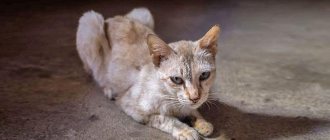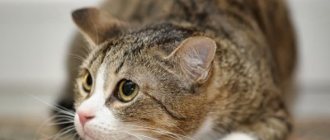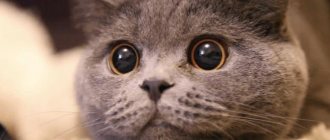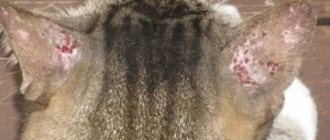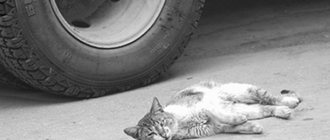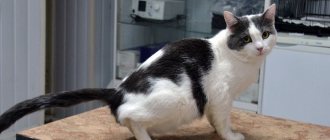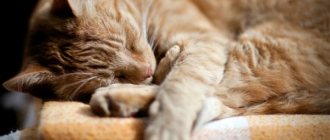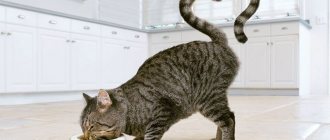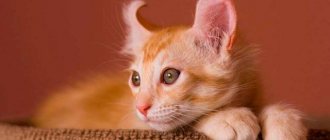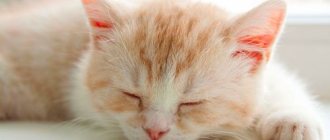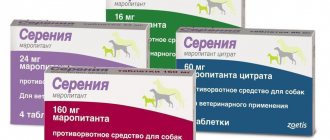Causes of diarrhea and vomiting in cats
It is necessary to determine the cause of the pet’s illness in order to provide assistance. To do this, note the duration of the onset of symptoms of diarrhea and vomiting. If symptoms of indigestion occurred within 24 hours and stopped on their own, then the cause is poisoning. Diarrhea and vomiting in cats is a reaction of the cat’s gastrointestinal tract to poor quality food or water. A sudden change in food also affects the digestion process.
Nausea, vomiting and diarrhea often occur in furry cat breeds due to the ingestion of large amounts of fur during licking. The resulting hairball makes digestion difficult, resulting in symptoms of diarrhea followed by vomiting.
Diarrhea with vomiting for more than a day indicates a serious disturbance in the digestion of food due to diseases or pathology of the gastrointestinal tract.
Diseases accompanied by diarrhea and vomiting
Loose stools are a symptom of many infectious diseases and pathologies of the digestive tract. The symptom develops due to poor digestion of food and inflammation of the mucous membrane of the walls of the stomach and intestines. Nausea and vomiting are a symptom of intoxication in the animal's body. The condition may be accompanied by vomiting with white foam.
Common causes of diarrhea and vomiting:
- Infectious diseases.
- Inflammatory processes in the gastrointestinal tract.
- Allergic reactions to food or household items.
- Parasitic lesion.
- Pathology of the kidneys and liver.
- Individual intolerance to food components.
- Sun and heatstroke.
- Tumors in the gastrointestinal tract.
Vomiting may occur after a strong blow to the abdominal area. In this case, it is necessary to exclude internal bleeding.
In what cases should you contact a veterinarian?
The situation becomes more complicated when the pet feels sick and vomits for more than a day, it becomes weak and lethargic and looks sick. If the cat does not go to the toilet or does not allow his stomach to be touched, you should urgently contact a veterinarian.
Other reasons to contact a specialist:
- After a starvation diet, the pet’s condition does not improve; he often vomits (several times an hour).
- If your cat doesn't eat anything all day. In this case, foamy vomit is most likely a sign of a serious illness.
- Vomiting is accompanied by severe thirst, and the cat does not go to the litter box. This indicates kidney pathology.
- Diarrhea, fever (above 38-39 ºС).
- Cramps. The symptom indicates damage to the central nervous system.
- Bloody discharge can be seen in the vomit.
- If your cat regularly spits up fur, his digestive system is not working properly. Your pet may have diseases of the gallbladder, pancreas or rectum.
Vomiting that does not stop for more than a day leads to dehydration. This condition poses a serious threat to life.
The following sign indicates severe dehydration with prolonged vomiting: lift an area of skin with your fingers and release it, it will slowly return to its original shape.
To prevent the death of the animal, you should not self-medicate. Be sure to show your cat to a veterinarian, who will determine the cause of vomiting and provide adequate therapy.
Diagnostics
To determine the cause of digestive disorders, it is necessary to monitor the cat’s condition and behavior. Pay attention to several criteria: the number of cases of vomiting and diarrhea, the color and consistency of feces and vomit, the presence of blood and other inclusions.
At the appointment, the doctor evaluates the animal’s appearance, interviews the owner about symptoms, vaccinations, nutrition, and duration of the disease. Additional research methods:
- analysis of stool for parasites and infectious agents;
- blood chemistry;
- Ultrasound examination of internal organs for the presence of neoplasms.
Diarrhea with vomiting for a day or more requires emergency veterinary attention!
Other possibilities
Another reason for the release of white foam from the stomach is malnutrition and even hunger . It just so happens that cats are very sensitive to lack of food. Their body will synthesize all the necessary digestive secretions in the same volumes for a long time, without reducing their quantity. If you don't feed your cat for a long time, the buildup of hydrochloric acid can cause stomach irritation. As a result, the same foamy vomit will occur. It is for this reason that the duration of a fasting diet for cats should not exceed one day .
Treatment
Treatment methods for diarrhea and vomiting in cats are divided into several stages - diet, medications, recovery period. First, nutrition is normalized, and in the first days of the disease, fasting is indicated. The selection of pharmacological agents is carried out by a veterinarian. The choice of drug depends on the symptoms.
Expert opinion
Dubas Andrey Leonidovich
Leading physician therapist at the veterinary clinic of Dr. Bugaev
Main criteria for therapy:
- antibiotics for infectious diseases;
- anthelmintics for parasitic infections;
- vitamin complexes to strengthen the immune system;
- probiotics to restore the natural intestinal microflora after a course of antibiotics;
- antihistamines – allergy medications;
- corticosteroids for anti-inflammatory effect;
- adsorbents – removing toxins from the body.
The dosage of drugs is determined by the doctor depending on the weight of the animal.
Medications
Many medications used for humans are suitable for treating diarrhea and vomiting in cats. Antibiotics of a certain series are prescribed for infections, the dose is determined by the doctor. Antiparasitic drugs are used under the supervision of a physician.
How to give pills and inject your pet
The owner does not always know how to carry out therapeutic manipulations with the pet. Here are some brief recommendations:
- If you need to give your cat a pill, dissolve the medicine in water. It's easier to drink from a syringe than to force someone to swallow. However, there are some who find it easier to give the whole tablet. To do this, you need to take your pet in your arms, open its mouth and put the pill on the tongue closer to its root. Immediately close the mouth and stroke the throat from the base of the jaw down, this will provoke the animal’s swallowing movements. It does not need to be released immediately, otherwise it may spit out the pill. If your pet does not sit quietly in your arms, you can wrap it in a blanket to immobilize it.
- How to stab a cat? If we are talking about injections under the withers, then the animal is placed with its stomach on a hard surface. A table is ideal. With your left hand you hold the animal behind its back, and with your right hand you insert a needle under the withers. It is more convenient to give the injection together. One person holds the pet, and the other stabs.
- It is more difficult with intramuscular injections. You will have to ask help from your household or neighbors. The cat must be held tightly because these injections are quite painful. The assistant holds the purr with both hands. It is best to hold the withers with your right hand and clasp your pet’s body with your left. The owner gives an injection in the right thigh. There is no need to treat the skin before the injection.
What to do if IVs are prescribed? It is almost impossible to do this at home. Therefore, the owner of the animal will have to take it to the veterinary clinic.
What to feed a sick cat with diarrhea and vomiting
In the first days of diarrhea, a diet is necessary for medicinal purposes. After treatment, returning to your usual diet should be done gradually. The digestive system needs time to recover. Give the animal lightly boiled boiled rice as food. Then add pieces of well-cooked chicken meat. Stick to this diet for a day. Gradually, the usual food is added to the rice, starting with small portions. The usual diet is restored a week after the end of the course of treatment.
Additionally, add special vitamins prescribed by your doctor to the food.
What to do if your cat is vomiting yellow foam?
If a cat vomits yellow foam, it means that bile has entered its stomach. The cause is diseases of the gastrointestinal tract (gastritis, colitis), biliary tract.
Yellowish vomiting in a cat can occur due to calcivirosis, a sudden change in diet, or a foreign body entering the stomach. If your pet has eaten stale or low-quality food, the load on the liver increases. In this case, vomiting of yellow liquid may also occur.
If you suspect that an inedible object or poor-quality food has entered the stomach, you need to provoke vomiting.
Give the animal a saline solution. To prepare it, stir 1 tablespoon of salt in 1 glass of warm water. Drink the solution until the cat begins to vomit.
If vomiting yellow foam was caused by poisoning, give your pet activated charcoal. In case of exacerbations of gastrointestinal diseases, exclude rough, fatty foods from the animal’s diet.
In severe cases, when vomiting with yellow foam was caused by infections, the cat should be taken to the veterinarian. In this case, you need to make droppers with saline solutions and medications.
Simple ways to provide first aid to an animal
In the case when your cat is vomiting water and foam, and no more threatening symptoms are observed, you can try to help your pet without resorting to veterinary help (or in cases where it is simply not possible to quickly get to the clinic). As a rule, a daily starvation diet can significantly alleviate the animal’s condition in many cases. The point is to “unload” the digestive system, in time during which the body can repair some damage. The main thing is that the animal must have unhindered access to drinking water (and boiled water).
If after a day the animal’s condition has stabilized and there are no more cases of vomiting, you can gradually soften the diet. At this time, you can start giving small amounts of boiled white rice in chicken broth. It is advisable to feed the animal five to six times a day, but in small portions, so as not to burden its digestive system. After two days, you should gradually increase the volume of portions, reducing their quantity and bringing it to the normal daily frequency of meals. If you have even the slightest doubt about stabilizing your pet’s condition, it is better to keep him on the diet longer (at least all week).
As for relieving common stomach disorders , oddly enough, many cats benefit from regular mint tea , which in similar cases is also effective for treating humans. Simply brew a cup of mint tea and let it cool to a temperature of 35-37 degrees Celsius. Immediately after vomiting, you need to pour about a tablespoon of this decoction into the cat. What to do if you suspect the presence of hairballs in your pet's stomach?
Preventive measures
Prevention will help protect your pet from many diseases. Simply follow these steps:
- create favorable conditions for the cat to eat and relieve its natural needs: clean bowls, fresh food and water, promptly replaced tray filler;
- carry out deworming once a quarter;
- treat for fleas and ticks;
- Keep cat beds, houses and litter clean. This is not difficult to do, just treat your pet’s favorite resting place with steam;
- undergo regular routine examinations by a veterinarian;
- If the animal suffers from chronic diseases of the gastrointestinal tract, provide it with specialized food.
Disease Prevention
Compliance with preventive measures, as well as careful attention to the health of the domestic cat and changes in its behavior will help to avoid many troubles. It is important to monitor your pet’s diet and prevent it from eating missing foods. Do not delay visiting the veterinarian if symptoms do not go away after 24 hours, as delay or improper treatment can lead to a worsening of the condition.
Video
Medications
After the examination, the doctor prescribes a comprehensive treatment based on the test results. Drugs are used depending on the identified disease:
- antiviral or antimicrobial;
- antibiotics;
- enzymes;
- adsorbents and probiotics;
- immunostimulants.
Drug treatment
Note! Also, to eliminate the consequences of intoxication of the body, the animal is prescribed IVs, enemas or gastric lavage.
When is surgery needed?
Surgery, if the cat has diarrhea and vomiting that does not stop even after taking medications, may be needed in the following cases:
- a foreign object was found in the animal’s gastrointestinal tract;
- diseases of the stomach or intestines, such as ulcers or erosion, have been identified;
- oncological diseases of the abdominal organs.
Surgery
In other cases, surgical intervention can be avoided if the disease is diagnosed in time and treatment is prescribed correctly.
